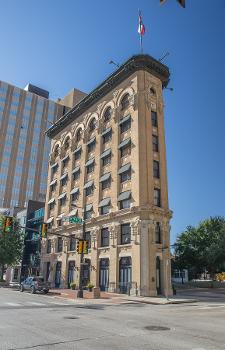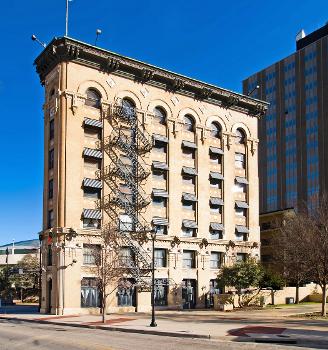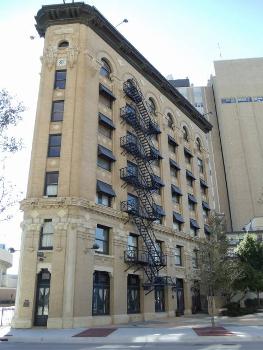General Information
| Completion: | 1907 |
|---|---|
| Status: | in use |
Project Type
| Structure: |
Frame |
|---|---|
| Material: |
Reinforced concrete structure |
| Architectural style: |
Neo-Renaissance |
Awards and Distinctions
| 1971 |
for registered users |
|---|
Location
| Location: |
Fort Worth, Tarrant County, Texas, USA |
|---|---|
| Address: | 1000 Houston Street |
| Coordinates: | 32° 45' 2.88" N 97° 19' 46.92" W |
Technical Information
Dimensions
| number of floors (above ground) | 7 |
Materials
| building structure |
reinforced concrete
|
|---|
Excerpt from Wikipedia
The Flatiron Building is located in downtown Fort Worth, Texas, at the corner of Houston and West 9th streets. At the time of its completion in 1907 it was one of the city's first steel frame buildings and the tallest building in north Texas.
History
Fort Worth's Flatiron Building was commissioned by local physician Dr. Bacon Saunders, who reserved the top floor for his offices, at a cost of $70,000. The building was to be located on a flatiron shaped corner and was originally known as Saunders' Triangle Building.
Early in the construction nearby merchants complained about the shadow that such a tall structure would cast over the downtown area, but their objections were eventually pacified by thoughts of the publicity the building would bring and Police Chief Maddox's promise to watch the construction site lest strong winds bring the girders down on them.
William Jenkins Worth, the man for whom the city of Fort Worth is named, is buried at the base of Manhattan's Flatiron Building, which inspired the design of the Fort Worth building.
Architecture
The building was designed by Fort Worth's top architectural firm Sanguinet & Staats in the renaissance revival style. It is constructed of reinforced concrete over a steel frame. The facade is divided into a two-story base supporting a five-story body capped by a heavily ornamented cast iron cornice. The east and west facades are further divided into bays by piers which rise to arches in the top level. The building carries further ornamentation in the form of carved panther heads above the second story and brick lozenges.
Interior design included open floor space to facilitate flexible division into offices. Additionally, "The elevator lobby of the Flatiron, with its handsome Classical details, ceramic tile floor, and marble wainscoting, as well as the ornate iron work of the elevator..." serves to illustrate the attention paid to the public areas of the building in order to entice clients.
The original design specified ten stories, but this had to be scaled back to seven due to budget concerns following the Panic of 1907.
The building is listed in the National Register of Historic Places.
Text imported from Wikipedia article "Flatiron Building (Fort Worth, Texas)" and modified on July 23, 2019 according to the CC-BY-SA 4.0 International license.
Participants
- Carl G. Staats (architect)
- Marshal R. Sanguinet (architect)
Relevant Web Sites
- About this
data sheet - Structure-ID
20029882 - Published on:
09/08/2007 - Last updated on:
01/04/2022


.jpg)






